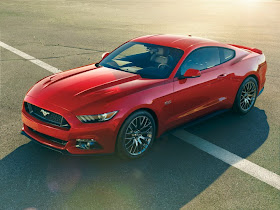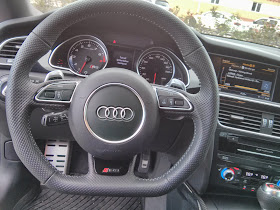The following article is an earlier post done for another website that is no longer in business. I've moved it here in an effort to consolidate all of my posts. Consider it ride back in to time. Enjoy!
 |
| 2013 BMW M5 |
It's been 40 years since BMW's secret skunkworks M Division has been pumping out uber powerful, yet subtly styled cars for the discerning executive driver. The kind of driver that wants super car performance without drawing attention to himself. Since it debuted, the M5 has been the de-facto bogey by which all other pretenders to the crown of super sports sedans are judged. Through each generation, the M5 offered opulent levels of luxury with seating for five, while packing enough horsepower and handling to make even the stalwart Ferrari jock think twice before a challenge.The last generation E60 M5 packed a Formula One inspired, high revving 5.0 liter V10 which powered the rear wheels with 507hp at a screaming 8200 rpm redline. Naturally aspirated, high revving engines have been a BMW M hallmark ever since the outfit's inception. Equipped with a fast shifting 7 speed sequential gearbox, the E60 could sprint from 0-60 in 4.5 seconds while belting out the closest thing to Formula One race car's engine wail. Despite this performance, the E60 was often derided as being too raw (one of my personal favorite qualities), too complicated (3 settings for the engine, 11 settings for the transmission plus countless others for varying systems) and the dimwittedness of the transmission when not going balls out. Basically, the M5 worked extremely well on the track but felt misplaced at saner speeds and calmer settings.
 |
| 2005-2010 E60 M5 |
Enter the new F10 model, which BMW probably wouldn't admit as much, but addresses most of the E60's minor (okay, major) shortcomings. Gone is the high revving-but-quite-thirsty V10 and herky-jerky SMG single clutch transmission, replaced by a new "M TwinPower Turbo" twin turbocharged, directed-injected, 4.4 liter V8 engine and an equally new seven speed dual clutch transmission to dole out the twin-turbocharged engine's impressive 560hp and 500 lb-ft of torque (more on this impressive yet major departure of an engine later). The basic 5 Series chassis has been substantially revised with an aluminum-intensive suspension (the rear components mounted in a rigid cradle to alleviate the flex of rubber bushings), an electronic version of the M differential which can split torque between the rear wheels for maximum grip, a tuned hydraulic steering rack (because the standard electronic unit lacked feel) and six piston brake calipers per wheel.
 |
| 2013 BMW M5 |
One of the more peculiar traits of the new F10 M5 is the engine's lack of aural character, at least compared with its raucous predecessor. The E60's V10 had such character that it made the hair on your skin stand up every time the driver touched the gas pedal. The new forced induction V8 on the other has hand is almost too refined. M engineers allegedly tried everything to alleviate this muffling effect of turbocharging (and the isolating effect of the 5's platform) by employing a number of options such as routing the intake housings closer to the firewall and cabin, installing microphones next to the intake and piping the sound directly into the cabin, none of which worked to their favor. They finally decided to use recorded sounds of the engine revving through its range and playing the sound back through the sound system in tune with the driver's placement of the throttle. Artificial yes, but it could be worse.
 |
| 2013 BMW M5 Interior |
One thing this new M5 improves on is in the electronics area. The E60 driver was simply overwhelmed with settings for everything controlling the car and no simple way to access or change them. This was the effect of the oft-derided iDrive system. The new F10 seeks to change this with simpler settings and easier access to them with either buttons or a simplified version of iDrive. Where the previous SMG transmission had ELEVEN (how quickly would you like your head snapped off?) settings, the V10 having THREE (how much power do you want?) settings along with a myriad others (some as trivial as allowing timer settings for the interior/exterior lights...really?), the F10 pares all of this customization down to the driving details in four simple modes: Economy, Comfort, Sport and Sport+. In Economy and Comfort mode, the transmission and suspension are tuned to make the M5 as docile as a regular 528i, the transmission slurring between gears (shooting for the highest in Economy) and the suspension absorbing bumps and giving a very compliant ride. Switch to Sport and the engine note becomes noticeably angrier, the transmission swaps gears more aggressively, steering gains more load and the suspension firms up. Sport+ stiffens up the springs even more, adds even more heft to the steering and turns the M5 into an apex eating, turn gobbling, straights chomping monster. These settings are programmable through two M buttons on the steering wheel, allowing the driver to customize and store preferences (easier done here than in the E60). North America can take comfort in the fact that unlike the previous M5 which offered a manual transmission late in its life cycle, one will be offered in the new F10 from the start (without the penalty of not being able to switch off traction and stability control completely...and the heavens rejoiced!)
 |
| 2013 BMW M5 |
Now, about that engine. Why turbos? Why forced induction? Why abandon a central theme important to M heritage by throwing away natural aspiration in favor of turbocharging? If you're an M enthusiast you can recall some time in BMW's history when uttering the term "forced induction" in a BMW building was akin to showing the Nazi sign. At Buckingham Palace. While dining with the Queen. It was unthinkable. Well, you'll have to get over it and cut BMW some slack. We now live in an era where fuel isn't as cheap as it once was and the reduction of vehicle emissions is now a central part of every automaker's R&D. The Germans are not immune to this and in order to comply with ever tightening emissions regulations, BMW has had to forego this central tradition (if you need any more proof, the next M3 will also use some form of turbocharging while downsizing from its current V8 back to a six cylinder). However, it's not all gloom and doom. With the new turbo V8 comes a new emphasis on economy. The S63B44Tu is an evolution of the S63 engine (itself a M-ified version of the regular N63 4.4 liter in 550i/750i sedans) used in the X5 M/X6 M high performance SUVs. As such, it boasts 30% better fuel economy ratings than the old 5.0 liter V10 of the E60. Sure the engine redlines at a tamer 7200 rpm, but for that you get 53 more horse over the old V10. Much more impressive is the jump in torque from 383lb-ft to an even 500lb-ft at a more accessible 1500rpm and the torque curve is as flat as the Great Plains. Drivers of the old M5 take notice: revving is not required but if you do, hang on.
Despite the F10 M5's gain in weight (thanks to the 5 Series architecture being based on the larger 7 Series) BMW has worked hard to minimize this penalty by using as much lightweight materials as possible throughout the car. Aluminum comprises the hood, fenders and doors as well as ultra high-strength steel through much of the chassis. Still the M5 comes it at a porky 4250lbs, some 200lbs heavier than the outgoing E60. Continuing the M tradition for Q ship styling, the M5 sports subtle exterior tweaks over the regular 5 Series that only the M faithful will identify at a distance. Larger air intakes at the front, larger fender flares framing 19 (or optional 20) inch wheels, a lowered suspension, the signature quad pipe exhaust and a subtle trunklid spoiler along with a sprinkling of M badges are among the calling cards for this cruise missile on wheels. Compared to the Bangle-esque styling of the E60 with its dramatic, flame surfaced exterior, the F10 model is quietly exotic. In many ways, it recalls the executive yet wolf-in-sheep's-clothes styling of the cult-status E39 model.
The 2013 BMW M5 should be on sale as of this writing at an MSRP of $90,795 (including $895 destination/handling). Go crazy with options like the Driver's Assistance package which includes systems such as blind spot warning, lane departure warning, side and top view cameras; the Executive package which further enhances luxury with heated rear seats and steering wheels, power trunklid, soft close doors plus a DVD entertainment system with screens in the front headrests (in case the kids get bored with your track driving) and you're looking at a price tag of well over $110,000. Eye watering for sure but look on the bright side, that Porsche driver in the next lane will never know what hit him.
Images courtesy of BMW


















